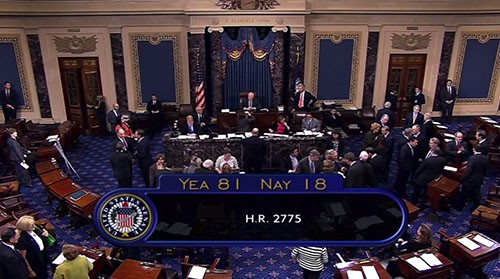Cronkite News has moved to a new home at cronkitenews.azpbs.org. Use this site to search archives from 2011 to May 2015. You can search the new site for current stories.
Federal budget deal includes wildfire funds, border guarantees
WASHINGTON – Tucked inside the bill that reopened the federal government late Wednesday night was language guaranteeing that border-security measures, specifically radar surveillance blimps, would continue to be funded into 2014.
The 14-page bill to reopen government agencies and extend the nation’s debt limit also included language for everything from retroactively paying furloughed federal employees to making a one-time $174,000 payment to the widow of the late Sen. Frank Lautenberg, D-N.J.
And some of these extras could end up benefiting Arizona.
Besides the border-security language, the bill appropriates a total of $636 million to the Interior and Agriculture departments for wildfire suppression, $15 million of which goes to burned-area rehabilitation.
The bill does does not attach a dollar figure to the requirement, but it calls for staffing levels of Customs and Border Protection officers and Immigration and Customs Enforcement agents to stay at pre-shutdown levels. Salaries and expenses for both agencies are to stay the same as well, the bill says.
It specifically directs the Department of Homeland Security to operate the Tethered Aerostat Radar System, a long-running border radar system that was threatened with being eliminated earlier this year.
The system consists of eight blimp-like balloons, tethered at spots along the border, that carry radar aloft to search for drug smuggling. Two of the balloons are in Arizona, one at Yuma and another at Fort Huachuca.
The system has been run for years by the Defense Department, which had proposed doing away with the aging program earlier this year. A 2012 report by the Government Accountability Office said the system cost $213.5 million to operate from 2007 to 2012.
But 16 members of Congress – including Arizona Reps. Ron Barber, D-Tucson, and Trent Franks, R-Glendale – wrote to the Pentagon asking it to shift control of the program to the Department of Homeland Security at the end of the fiscal year – Sept. 30.
That letter said ending the program would “substantially degrade counter-narcotics operations because a suitable alternative to TARS has not been identified.”
The Pentagon agreed to keep the balloons flying until the end of fiscal 2013 and in April then-Homeland Security Secretary Janet Napolitano asked for $37.4 million in her department’s 2014 budget to take over operation of TARS.
Barber welcomed the inclusion of the program in the late-Wednesday budget deal, calling it essential for border security.
“I am pleased that this funding will ensure that our Southern Arizona aerostats continue to fly,” Barber said in a statement emailed from his office Thursday.
The system has been in use for more than two decades, according to its congressional supporters.
“They (the blimps) are aging to say the least,” said Ronald Colburn, former deputy chief of the Border Patrol, in an email Thursday. “Perhaps ‘ancient’ describes them better.”
Besides being old, Colburn said the system is expensive to maintain, one reason the Pentagon wanted to drop it.
Not everyone welcomes the extension of the program. But Vicki Gaubeca, director of the Regional Center for Border Rights of the American Civil Liberties Union-New Mexico, said she was not surprised by the move.
“Congress continues to support bloated law enforcement efforts along the border,” said Gaubeca, who thinks the blimps and the number of officers on the border are unnecessary.










